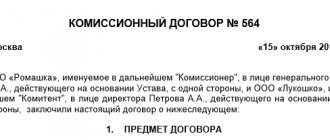The concept of a contract for the carriage of goods
The DPG establishes the relationship between the cargo supplier and the cargo carrier.
When creating such a transaction, the latter assumes the responsibility for transporting the cargo transferred to him by the supplier to the specified address and transferring it completely intact to the consignee. At the same time, the shipper undertakes to pay the cargo carrier for the work performed (clause 1 of Article 785 of the Civil Code; cf. Article 25 UZhT, Article 103 VK, Article 67 KVVT, Article 18 UAT). In legal terms, the agreement is considered bilateral, concluded in favor of the third party - the recipient of the cargo. If the movement of cargo is carried out by public transport (TS) (Article 789 of the Civil Code), payment for its transportation is carried out according to the tariffs established by the transport code and charter.
DPG can be issued:
- For a one-time consignment and is regulated by transport legislation.
- For long-term action, where the movement of an individual batch is a minor aspect of the obligation under the DPG.
In addition to the ordinary DRG, there is a consensual charter contract (charter), used in sea and air transport (Article 115 KTM and Article 104 VK). According to such a contract, the charterer assumes responsibility - to provide the charterer, for a contractual payment, with transportation of goods, by one or many vehicles for one or many flights (Part 1 of Article 787 of the Civil Code).
With the help of a charter, legal relations regarding the transportation of bulk cargo of the same type are regulated. For these purposes, tramp vessels operating without a schedule are most often used.
Form of contract for the carriage of goods
After signing the DPG, the cargo carrier is issued a document for the goods (TTN, bill of lading or other form) established by the Transport Code (clause 2 of Article 785 of the Civil Code).
The consignment note, according to the general provisions, is drawn up by the shipper and handed over to the carrier along with the delivery of the goods to him for transportation to the specified address. This document is completed in writing, displaying the terms of the contract.
Conclusion of a contract for railway transport.
- When transporting goods by rail, the TTN is drawn up with a railway manifest that simultaneously accompanies the cargo, i.e. the cargo is accompanied throughout the transportation route, and also confirms the progress of the carrier’s fulfillment of contractual obligations. This statement, together with the transported goods, is issued to the consignee against signature, which is placed in the corresponding column of the tear-off coupon of the road statement, located at the departure station.
- At the same time, the shipper is subject to property liability for the untruthfulness of the data entered in the railway TTN (Article 27 of the UZhT).
- A similar function is performed by the TTN when transporting goods by inland water transport (Article 67 KVVT) and by cargo TTN when transporting goods by air (Article 105 VK).
Drawing up a contract for sea transportation of goods.
Signing of the CPG by sea is carried out depending on the type of goods:
- Transportation according to the bill of lading.
- Charter transportation.
According to the bill of lading
The bill of lading is signed by the cargo carrier as a result of the contract (loading order) concluded by the shipper, with information about the supplier and consignee of the goods, the port of unloading and all data about the goods, including:
- Titles.
- Markings.
- Properties
- Number of places.
- Packaging.
- Appearance.
A bill of lading for goods sent for export is issued after loading the goods onto the ship based on the navigator's receipt. The shipper is responsible for the untruthfulness of the data recorded in the bill of lading and is responsible for damage caused to the cargo carrier due to unreliable information (clause 2 of Article 142 of the Code of Labor Code).
A bill of lading is considered a form certifying the conclusion of a contract for transporting goods by sea, a certificate of transfer of goods to the carrier, as well as a cargo title form (Article 143 of the Civil Code).
It must display details about:
- the cargo carrier, supplier and consignee of the goods;
- loading and unloading ports;
- properties and condition of the product, as well as its packaging;
- amount of freight;
- time and place of delivery of the bill of lading, and the number of copies.
The cargo supplier, who has signed an agreement with the carrier, has the right to dispose of the goods before handing it over to the consignee, or before handing over the bill of lading to the consignee or a third party, of which the supplier is obliged to notify the carrier (Article 149 of the KTM).
By charter.
The charter is usually drawn up on standard printed forms, made taking into account the nature of transportation, types of goods and directions of transportation, i.e. the form looks like an appendix to the contract. The charter is required to display (Article 120 KTM):
- Name of the parties to the transaction.
- Name of the ship.
- Kind and type of goods.
- Freight amount.
- Name of the loading location.
- Ship's destination address.
- Other conditions and requirements.
When transporting goods under a charter, a bill of lading is also drawn up, reflecting the legal relationship between the cargo carrier and the consignee who is not a party to the agreement for transporting the goods. The conditions of the charter for the consignee are mandatory only when applied to the bill of lading (Article 119 of the Code of Labor Code).
Based on Art. 121 of the KTM, it is possible to assign charter rights by the charterer, with the permission of the carrier, to a third party, with joint liability to the carrier for failure to comply with the terms of the maritime contract for the transportation of goods.
Subject of the agreement
The subject of the DPG depends on the type of contract signed.
The object of such a contract is a product of a certain value. The subjects of such an agreement are the shipper of the goods, the carrier and the recipient of the goods. The subject of the DPG is the transportation of goods transferred to the carrier from the point of dispatch to the point of delivery. These services include the safety of goods, their delivery and often loading/unloading.
All of the above actions ensure the fulfillment of the contract for the transportation of goods, that is, its delivery and integrity during transportation.
Obligations of the carrier under the contract for the carriage of goods
When signing any contract between the parties to the transaction, a section is required that stipulates the obligations of the parties.
DPG is no exception. In the signed contract, the cargo carrier is responsible for:
- Transportation of goods to the established address shown in the TTN or bill of lading.
- Compliance with the delivery time specified in the contract.
- Ensuring the integrity of the transported goods, after its acceptance from the supplier, for transportation to the place of transfer to the consignee.
- Transfer of goods to the consignee.
What to pay attention to when drawing up a contract
If you act as a shipper and have already decided on the choice of carrier company, request a standard application agreement for the services provided. According to generally accepted rules, an application for a transportation contract must be drawn up by the carrier. Depending on the characteristics of the cargo, the shipper may introduce conditions that affect the integrity of the parcel or the speed of delivery. We recommend specifying the specifics of packaging, loading/unloading, the amount of compensation and the procedure for compensation for damage or loss of the shipment.
If you are the carrier party, then you need to develop your own standard form. To do this, you can use the sample contract application attached below. In addition to indicating the starting and ending points of the route, we recommend defining the order in which the route will be taken. Always indicate the amount of liability for late payment by the shipper.
(filled)
Obligations of the shipper under the contract for the carriage of goods
When signing a DPG, the consignor assumes the following obligations:
- Ensuring timely delivery of goods to the carrier.
- Prepayment for transportation of goods, if this is reflected in the contract.
- Final payment for cargo transportation.
In addition, it must be borne in mind that the shipper is responsible for issuing the accompanying specifications to the cargo carrier, required for the smooth transportation of goods in accordance with the legislation of the Russian Federation. The supplier of the goods is responsible for the correct execution of the TTN.
If the data entered into the accompanying materials is incorrect, the consignor will compensate for the damage to the carrier.
Term
The term in the DPG indicates the time during which the goods must be provided to the recipient.
Transportation times are calculated by the transport code and displayed in the contract (Article 792 of the Civil Code of the Russian Federation). In case of mixed transportation, the transportation time is set based on a set of terms, based on the rules in force for the relevant types of vehicles. The transportation period for goods is observed taking into account its loading/unloading by the carrier. The carrier's liability for failure to comply with the contractual terms of transportation of goods can be expressed in the form of a penalty (for example, for failure to deliver on time (clause 1 of Article 400 of the Civil Code of the Russian Federation)).
Parties to the agreement
The parties to the CPG are the consignor and the cargo carrier.
The consignor is an individual or legal entity acting on his own behalf or the owner of the goods and is displayed in the TTN. The consignor can be either the owner of the goods or his representative acting on his behalf.
The carrier is a legal entity. a person or individual entrepreneur who has undertaken the obligation to transport the goods to the recipient.
The recipient of the goods is not considered a party to the contract, but only a third party. He can be an individual or an institution that has the authority to accept the imported goods.
How to properly draw up a contract for cargo transportation in 2020?
To transport goods, in order to be sure of its timely delivery and maintaining its integrity, it is necessary to conclude a contract between the shipper and the carrier.
The documents required for transporting goods must be written in such a way as to ensure the integrity of the cargo and its timely delivery.
Let's consider how to correctly draw up a contract for the transportation of goods in order to minimize tax risks?
Today, given the presence of unscrupulous counterparties, the conclusion of a DPG is a fundamental possibility of calculating tax benefits (if the taxpayer exercises the necessary diligence).
Judicial practice has precedents for the unjustified recognition of tax benefits as a result of the absence of actual transportation of goods. Therefore, the fact of actual delivery of cargo must be documented.
DPG is an agreement between the consignor and the carrier, according to which the latter must transport the goods handed to him from the place of departure to the destination, and receive payment for the work performed.
To correctly draw up a contract, you need to fill out the following sections of the document:
1. Preamble
This section is the introductory part of any agreement. It displays the place and time of filling out the document, and displays the parties to the contract. The concepts of “shipper” and “commodity carrier” are given.
2. Subject of the agreement
The current section displays the services provided for the transportation of goods and the terms of the transaction. Here you can indicate the customer's obligation to pay the costs for the work performed.
3. Rights and obligations of the parties
This section displays the obligations of the shipper and the cargo carrier, where participants assume obligations.
The consignor is obliged:
- Pay the carrier the cost of the work performed.
- Issue the required documents for the cargo.
- Hand over the cargo intact for transportation.
Note. The shipper may refuse to transfer the goods to the carrier if the vehicle for transportation does not meet the requirements.
The carrier is obliged:
- Provide the vehicle within the time specified in the contract.
- Ensure acceptance of the goods from the consignor and transfer them to the recipient intact in accordance with the accompanying documents.
- Provide new transport if a vehicle malfunction occurs during transportation.
- Provide the recipient with documents confirming the transfer of the goods at the point of acceptance.
- Provide measures to salvage property in the event of an accident, damage to seals, or theft of cargo by third parties.
Note. The carrier may refuse to accept the goods for transportation if damage to the packaging is detected during loading.
4. Payment procedure
Here it is necessary to set out the method and terms of payment for services performed. The amount is usually displayed in the protocol attached to the agreement. Here you can also display penalties for late payments.
5. Responsibility of the parties
This section is intended to describe the parties' responsibilities for non-compliance with the terms of the contract. All conditions and penalties must comply with the legislative norms of the Russian Federation.
6. Dispute resolution procedure
Both parties to the transaction, if controversial situations arise, must set out in this section what measures they can take in such circumstances, including providing for resolution of the conflict in court.
7. Force majeure
As a rule, every contract contains such a section. Force majeure includes situations that result in violation of contract terms beyond the control of the parties to the agreement. This may include strikes, natural disasters, etc.
In such circumstances, the parties may be partially or completely excused from complying with the contract. The parties must inform each other of this fact.
8. Validity period
When concluding a DPG, the parties are required to specify the beginning of the agreement and its expiration date. As a rule, if the DPG has not been terminated upon its completion, then it can be considered extended for another year.
9. Other conditions
This paragraph may display other requirements that were not displayed in previous sections.
10. Details and signatures of the parties
This section is final. The bank details, contact information and signatures of the parties to the transaction are displayed here.
Having completed all sections, the parties to the agreement must once again check the data entered in the document, and after signing it, exchange copies and wish each other compliance with all the conditions displayed in the signed agreement.
It is suggested to watch the video on the advice of a lawyer when concluding a DPG.
( Video : “Cargo transportation - legal advice”)
Sample contract for the carriage of goods 2020
Price of the contract for the carriage of goods
Today, the market economy requires timely payments for services performed when transporting goods (Article 785 of the Civil Code of the Russian Federation).
One of the points for the delivery of goods is determining the cost of the services provided for its transportation, and displaying the terms and conditions of payment. The text of the contract must indicate the procedure for performing calculations. Typically, carriers have published tariffs for the provision of cargo transportation services. Before signing the contract, customers are familiarized with the prices, which subsequently become an integral annex to the contract. If tariffs change, the carrier is obliged to notify the customer about this.
In practice, the following calculation procedure is used:
- The forwarder presents the invoice to the customer.
- The latter pays by bank transfer.
- Payment is usually made within 3-5 days from the date of presentation of the invoice.
Contract structure
Federal legislation does not establish the form of the application agreement that the parties to the transaction must adhere to. Based on the requirements of Chapter 40 of the Civil Code of the Russian Federation and established legal practice, the application-contract for the carriage of goods by road contains the following conditions:
- information about the parties (name and basic details, signatures of authorized persons);
- information about the cargo (cost, quantity, type of loading/unloading);
- route (place of loading/unloading, time of arrival at final and starting points);
- payment (cost of services provided; procedure for making payments);
- vehicle data (type of transport, identification number, driver contact details);
- penalties (liability for non-fulfillment or improper execution of the agreement).
In appearance, the document often has a table design, this allows you to visually quickly navigate the text of the document and find key terms.









